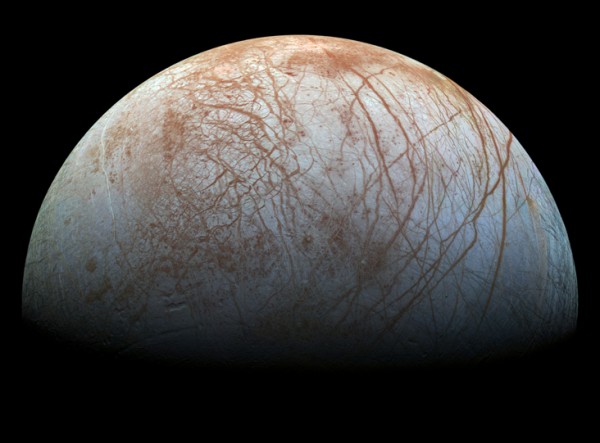NASA will Send a Spacecraft to Explore Jupiter's Mysterious Moon, Europa
| Ana Verayo | | Feb 04, 2015 02:29 AM EST |
(Photo : NASA/JPL-Caltech/SETI Institute) A color view of Europa from Galileo that shows the largest portion of the moon's surface at the highest resolution.
NASA Administrator Charles Bolden announced Monday that NASA is now selecting projects for a space probe that will journey to Jupiter's moon, Europa.
Europa is about 390 million miles from Earth and is made of icy rock. Scientists believe a massive ocean is hidden beneath its icy surface.
Like Us on Facebook
This ocean is so vast and massive scientists presume that Europa contains as much as two or even three times the amount of liquid water on Earth.
Since there's a lot of liquid water on Europa, this gives the moon great potential for microbial life.
Europa is 1,900 miles in diameter, which is somewhat smaller that our own Moon. It's also criss-crossed by mysterious brown veins running along its surface. Scientists believe this feature indicates Europa's crust cracked open. Warmer and dirtier water that accumulated and froze over time caused the brown streaks.
Jupiter has an undeniable powerful gravitational force on the small moon that produces tidal waves on it, making its surface stretch which is comparable how the Moon's gravity affect the Earth's oceans, producing tides. This phenomenon makes Europa's crust crack as water seeps beneath the surface.
NASA astrobiologist Kevin Hand says Jupiter has an even greater effect on Europa. Scientists believe liquid water on the moon causes the tidal movements that flex Europa up and down. This tidal energy transforms into friction and heat that keeps liquid water under its icy shell.
A relatively new feature on Europa called Pywll is an impact crater considered solid evidence of a colossal ocean flowing beneath the surface. Scientists believe that when the impact occurred, it splattered fresh and fine water ice particles across Europa. These water particles now appear as bright white arms pock marking the moon's face near the darker crater.
NASA's Galileo spacecraft was the only probe to fly-by Europa more than once. It took photos of this crater measuring about 16 miles in diameter.
To date, President Barack Obama proposed an US$18.5 billion budget for NASA that will hopefully get this Jupiter space mission going.
TagsNASA Will Send Spacecraft to Explore Jupiter's Mysterious Moon Europa, NASA, Jupiter, Europa, NASA space mission jupiter moon europa, jupiter moon europa
©2015 Chinatopix All rights reserved. Do not reproduce without permission
EDITOR'S PICKS
-

Did the Trump administration just announce plans for a trade war with ‘hostile’ China and Russia?
-

US Senate passes Taiwan travel bill slammed by China
-

As Yan Sihong’s family grieves, here are other Chinese students who went missing abroad. Some have never been found
-

Beijing blasts Western critics who ‘smear China’ with the term sharp power
-

China Envoy Seeks to Defuse Tensions With U.S. as a Trade War Brews
-

Singapore's Deputy PM Provides Bitcoin Vote of Confidence Amid China's Blanket Bans
-

China warns investors over risks in overseas virtual currency trading
-

Chinese government most trustworthy: survey
-

Kashima Antlers On Course For Back-To-Back Titles
MOST POPULAR
LATEST NEWS
Zhou Yongkang: China's Former Security Chief Sentenced to Life in Prison

China's former Chief of the Ministry of Public Security, Zhou Yongkang, has been given a life sentence after he was found guilty of abusing his office, bribery and deliberately ... Full Article
TRENDING STORY

China Pork Prices Expected to Stabilize As The Supplies Recover

Elephone P9000 Smartphone is now on Sale on Amazon India

There's a Big Chance Cliffhangers Won't Still Be Resolved When Grey's Anatomy Season 13 Returns

Supreme Court Ruled on Samsung vs Apple Dispute for Patent Infringement

Microsoft Surface Pro 5 Rumors and Release Date: What is the Latest?










